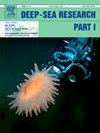挑战者深沉积物强磁性、地球化学特征及其来源指示
IF 2.1
3区 地球科学
Q2 OCEANOGRAPHY
Deep-Sea Research Part I-Oceanographic Research Papers
Pub Date : 2025-01-25
DOI:10.1016/j.dsr.2025.104455
引用次数: 0
摘要
了解海沟沉积物的性质是了解海沟沉积物来源及其输运变化的重要方面。本研究基于在马里亚纳海沟10,815 m深处获取的MT20-750岩心的环境磁性特征和地球化学特征,旨在确定沉积物的来源,并了解驱动沉积物来源变化的机制。MT20-750岩心近端沉积物来源主要为南太平洋板块蚀变基岩组分和北菲律宾板块火山喷发物质,远端沉积物来源主要为风沙输入,生物物质也有贡献。挑战者深沉积物的总体磁化率值明显较高,达到太平洋其他区域的3-5倍。这些沉积物的强磁性主要是由于在太平洋底水作用下,以富铁镁玄武岩(基性玄武岩)为主的南部俯冲板块岩的蚀变增强所致。这代表了沉积物流入沟槽轴线并在氧化环境中保存的正常状态。而菲律宾海板块北部的沉积物主要由凝灰岩组成,Fe、Mg和Ti含量较低,在地震事件或浊流期间间歇性进入海沟。这些事件改变了海沟沉积物的组成,导致磁化率值降低,物源的变化主要是由地质作用强度的变化和特定的输沙条件驱动的。本文章由计算机程序翻译,如有差异,请以英文原文为准。
Strong magnetism and geochemical characteristics of sediment in Challenger Deep and their indications for sources
Understanding the properties of trench sediments is an important aspect of comprehending the sources and transport variations of trench sediments. This study seeks to identify the sources of sediment and understand the mechanisms driving sediment source variation in the Challenger Deep, based on the environmental magnetic characteristics and geochemical properties of the MT20-750 core retrieved from a depth of 10,815 m in the Mariana Trench. The proximal sediment source of the MT20-750 core comprises mainly altered bedrock components from the southern Pacific Plate and volcanic eruption materials from the northern Philippine Plate, while the distal source is primarily aeolian dust input, with biogenic materials also contributing. The overall magnetic susceptibility values of the sediments in the Challenger Deep are significantly higher, reaching 3–5 times that of other regions in the Pacific Ocean. The strong magnetic properties of these sediments are primarily due to the enhanced alteration of the southern subducting plate rocks, which are mainly composed of basalt rich in iron and magnesium (mafic basalt), under the action of Pacific bottom water. This represents a normal state when sediments are funneled into the trench axis and preserved in an oxidizing environment. However, the sediments from the northern Philippine Sea Plate, mainly composed of tuffaceous rocks with lower Fe, Mg, and Ti content, intermittently enter the trench during seismic events or turbidity flows. These events alter the sediment composition in the trench, leading to a decrease in magnetic susceptibility values, with the change in provenance primarily driven by the varying intensity of geological processes and the specific conditions of sediment transport.
求助全文
通过发布文献求助,成功后即可免费获取论文全文。
去求助
来源期刊
CiteScore
4.60
自引率
4.20%
发文量
144
审稿时长
18.3 weeks
期刊介绍:
Deep-Sea Research Part I: Oceanographic Research Papers is devoted to the publication of the results of original scientific research, including theoretical work of evident oceanographic applicability; and the solution of instrumental or methodological problems with evidence of successful use. The journal is distinguished by its interdisciplinary nature and its breadth, covering the geological, physical, chemical and biological aspects of the ocean and its boundaries with the sea floor and the atmosphere. In addition to regular "Research Papers" and "Instruments and Methods" papers, briefer communications may be published as "Notes". Supplemental matter, such as extensive data tables or graphs and multimedia content, may be published as electronic appendices.

 求助内容:
求助内容: 应助结果提醒方式:
应助结果提醒方式:


